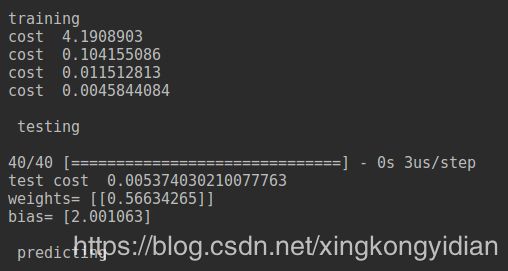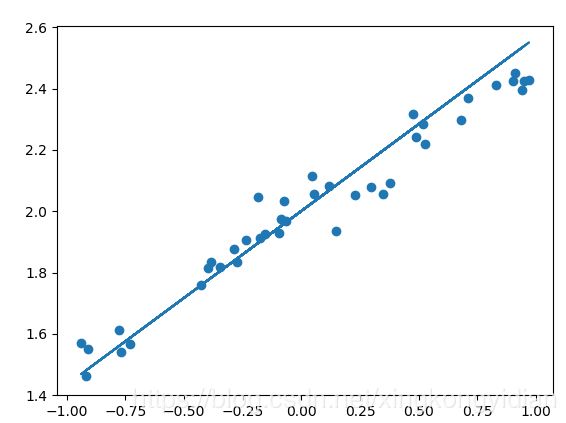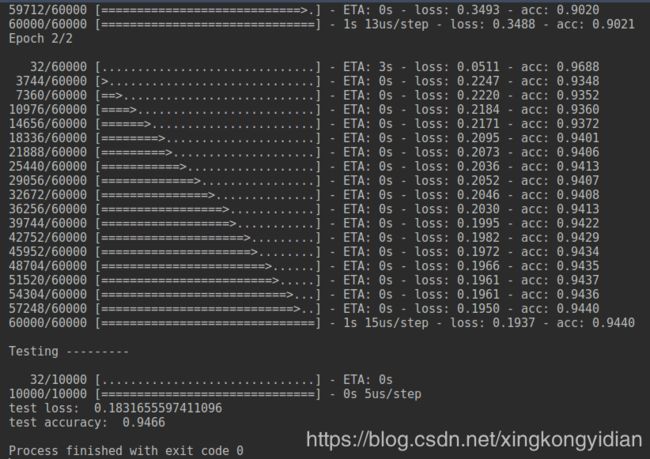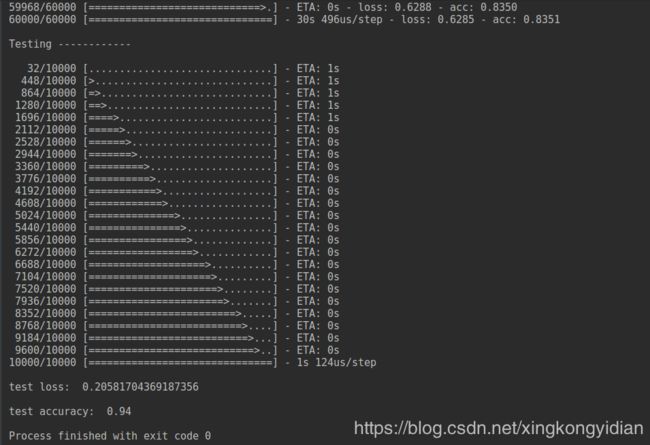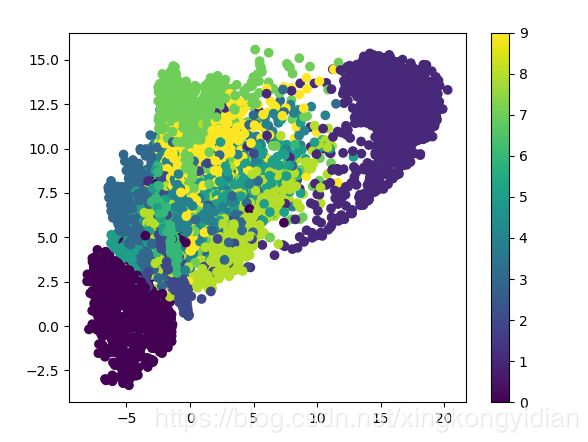keras 搭建神经网络
1 简单的回归
#coding=utf-8
import numpy as np
np.random.seed(1337)
from keras.models import Sequential
from keras.layers import Dense
import matplotlib.pyplot as plt
# create some data
X = np.linspace(-1, 1, 200)
np.random.shuffle(X)
Y = 0.5*X + 2 + np.random.normal(0, 0.05, (200,))
#plot data
plt.scatter(X, Y)
plt.show()
X_train, Y_train = X[:160], Y[:160]
X_test, Y_test = X[160:], Y[160:]
plt.scatter(X_test, Y_test)
plt.show()
# build a neural network from the 1st layer to the last layer
model = Sequential()
model.add(Dense(units=1, input_shape=(1,)))
# choose loss function and optimizing method
model.compile(optimizer='sgd', loss='mse')
#training
print('\ntraining')
for step in range(301):
cost=model.train_on_batch(X_train, Y_train)
if (step %100 == 0):
print('cost ', cost)
#test
print('\n testing')
cost = model.evaluate(X_test, Y_test, batch_size=40)
print('test cost ', cost)
W, b = model.layers[0].get_weights()
print('weights=', W, '\nbias=', b)
# plotting the prediction
print('\n predicting')
Y_pred = model.predict(X_test)
plt.scatter(X_test, Y_test) # scatter 点
plt.plot(X_test, Y_pred) # plot 线
plt.show()
2 简单的分类
#coding=utf-8
import numpy as np
np.random.seed(1337)
import matplotlib.pyplot as plt
from keras.models import Sequential
from keras.datasets import mnist
from keras.utils import np_utils
from keras.layers import Dense, Activation
from keras.optimizers import RMSprop
#X shape(60000 28*28) , y shape(10000, )
(X_train, y_train), (X_test, y_test)=mnist.load_data()
# data pre-processing
X_train =X_train.reshape(X_train.shape[0], -1)/255 # normalize
X_test = X_test.reshape(X_test.shape[0], -1)/255 # normalize
y_train = np_utils.to_categorical(y_train, num_classes=10) # one-hot
y_test = np_utils.to_categorical(y_test, num_classes=10) # one-hot
print('x_train shape: %d' %(X_train.shape[0]))
print('\nx_test shape: %d' %(X_test.shape[0]))
# Another way to build neural net
model = Sequential([
Dense(32, input_dim=784),
Activation('relu'),
Dense(10),
Activation('softmax'),
])
# Another way to define optimizer
rmsprop =RMSprop(lr=0.001, rho=0.9, epsilon=1e-08, decay=0.0)
# add metrics to get more results we want
model.compile(optimizer=rmsprop,
loss='categorical_crossentropy',
metrics=['accuracy'])
print('Training --------')
# Another way to train model
model.fit(X_train, y_train, epochs=2, batch_size=32)
print('\nTesting ---------')
# evaluate the model with the metrics we defined earlier
loss, accuracy = model.evaluate(X_test, y_test)
print('test loss: ', loss)
print('test accuracy: ', accuracy)
3 CNN
#coding=utf-8
import numpy as np
np.random.seed(1337) # for reproducibility
from keras.datasets import mnist
from keras.utils import np_utils
from keras.models import Sequential
from keras.layers import Dense, Activation, Convolution2D, MaxPooling2D, Flatten
from keras.optimizers import Adam
# download the mnist to the path '~/.keras/datasets/' if it is the first time to be called
# training X shape (60000, 28x28), Y shape (60000, ). test X shape (10000, 28x28), Y shape (10000, ) 1
(x_train, y_train), (x_test, y_test) = mnist.load_data()
# data pre-processing 4
x_train = x_train.reshape(-1, 1, 28, 28)/255.
x_test = x_test.reshape(-1, 1, 28, 28)/255.
y_train = np_utils.to_categorical(y_train, num_classes=10)
y_test = np_utils.to_categorical(y_test, num_classes=10)
# Another way to build your CNN 1
model = Sequential()
# Conv layer 1 output shape (32, 28, 28)
model.add(
Convolution2D(
batch_input_shape=(None, 1, 28, 28),
filters=32,
kernel_size=(5, 5),
strides=1,
padding='same',
data_format='channels_first',
)
)
model.add(Activation('relu'))
# Pooling layer 1 (max pooling) output shape (32, 14, 14)
model.add(MaxPooling2D(
pool_size=2,
strides=2,
padding='same',
data_format='channels_first',
))
# Conv layer 2 output shape (64, 14, 14)
model.add(Convolution2D(filters=64,
kernel_size=(2, 2),
strides=(2, 2),
padding='same',
data_format='channels_first',
))
model.add(Activation('relu'))
# Pooling layer 2 (max pooling) output shape (64, 7, 7)
model.add(MaxPooling2D(pool_size=(2, 2),
data_format='channels_first'
))
# Fully connected layer 1 input shape (64 * 7 * 7) = (3136), output shape (1024) 3
model.add(Flatten())
model.add(Dense(1024))
model.add(Activation('relu'))
# Fully connected layer 2 to shape (10) for 10 classes 2
model.add(Dense(10))
model.add(Activation('softmax'))
# Another way to define your optimizer 1
adam = Adam(lr=1e-4)
# We add metrics to get more results you want to see 1
model.compile(optimizer=adam,
loss='categorical_crossentropy',
metrics=['accuracy'])
print('Training ------------')
# Another way to train the model 1
model.fit(x=x_train, y=y_train, epochs=1, batch_size=64,)
print('\nTesting ------------')
# Evaluate the model with the metrics we defined earlier 1
loss, accuracy = model.evaluate(x=x_test, y=y_test)
print('\ntest loss: ', loss)
print('\ntest accuracy: ', accuracy)
4 RNN classifier
#coding=utf-8
import numpy as np
np.random.seed(1337) # for reproducibility
from keras.datasets import mnist
from keras.utils import np_utils
from keras.models import Sequential
from keras.layers import SimpleRNN, Activation, Dense
from keras.optimizers import Adam
# 设置time_steps, input_size, batch_size, batch_index , output_size, cell_size 和lr
TIME_STEPS = 28
INPUT_SIZE = 28
BATCH_SIZE = 50
BATCH_INDEX = 0
OUTPUT_SIZE = 10
CELL_SIZE = 50
LR = 0.0001
# download the mnist to the path '~/.keras/datasets/' if it is the first time to be called
# X shape (60,000 28x28), y shape (10,000, )
(x_train, y_train), (x_test, y_test) = mnist.load_data()
# data pre-processing
x_train = x_train.reshape(-1, 28, 28)/255 #normlize
x_test = x_test.reshape(-1, 28, 28)/255
y_train = np_utils.to_categorical(y_train, num_classes=10)
y_test = np_utils.to_categorical(y_test, num_classes=10)
# build RNN model
model = Sequential()
# RNN cell
model.add(SimpleRNN(
batch_input_shape=(None, TIME_STEPS, INPUT_SIZE),
units=CELL_SIZE
))
# output layer
model.add(Dense(
OUTPUT_SIZE
))
model.add(Activation('softmax'))
# optimizer
adam = Adam(LR)
model.compile(optimizer=adam,
loss='categorical_crossentropy',
metrics=['accuracy'])
# training
for step in range(8001):
X_batch = x_train[BATCH_INDEX: BATCH_INDEX + BATCH_SIZE,:,:]
Y_batch = y_train[BATCH_INDEX: BATCH_INDEX + BATCH_SIZE,:]
cost = model.train_on_batch(X_batch, Y_batch)
BATCH_INDEX +=BATCH_SIZE
BATCH_INDEX =0 if BATCH_INDEX>= x_train.shape[0] else BATCH_INDEX
if step % 500 ==0:
cost, accuracy = model.evaluate(x_test, y_test, batch_size=x_test.shape[0], verbose=False)
print('test cost:', cost, 'test accuracy: ', accuracy)
5 RNN regressor
#coding =utf-8
import numpy as np
np.random.seed(1337) # for reproducibility
import matplotlib.pyplot as plt
from keras.models import Sequential
from keras.layers import LSTM, TimeDistributed, Dense
from keras.optimizers import Adam
#设置 batch_start、 time_steps 、 batch_size、 input_size output_size cell_size 和LR
BATCH_START = 0
TIME_STEPS = 20
BATCH_SIZE = 50
INPUT_SIZE = 1
OUTPUT_SIZE = 1
CELL_SIZE =20
LR = 0.006
def get_batch():
global BATCH_START, TIME_STEPS
# xs shape (50batch, 20steps)
xs = np.arange(BATCH_START, BATCH_START+TIME_STEPS*BATCH_SIZE).reshape((BATCH_SIZE, TIME_STEPS)) / (10*np.pi)
seq = np.sin(xs)
res = np.cos(xs)
BATCH_START += TIME_STEPS
# plt.plot(xs[0, :], res[0, :], 'r', xs[0, :], seq[0, :], 'b--')
# plt.show()
return [seq[:, :, np.newaxis], res[:, :, np.newaxis], xs]
#build model
model = Sequential()
# build a LSTM RNN
model.add(LSTM(
batch_input_shape=(BATCH_SIZE, TIME_STEPS, INPUT_SIZE),
units=CELL_SIZE,
return_sequences=True,
stateful=True
))
# add output layer
model.add(TimeDistributed(Dense(OUTPUT_SIZE)))
adam = Adam(lr=LR)
model.compile(optimizer=adam,
loss='mse'
)
print('Training ------------')
for step in range(501):
X_batch, Y_batch, xs =get_batch()
cost = model.train_on_batch(X_batch, Y_batch)
pred = model.predict(X_batch, BATCH_SIZE)
plt.plot(xs[0, :], Y_batch[0].flatten(), 'r',
xs[0, :], pred.flatten()[:TIME_STEPS], 'b--')
plt.ylim((-1.2, 1.2))
plt.draw()
plt.pause(0.1)
if step %10 ==0:
print('train cost: ', cost)
6 autoencoder
#coding=utf-8
import numpy as np
np.random.seed(1337) # for reproducibility
from keras.datasets import mnist
from keras.models import Model
from keras.layers import Dense, Input
import matplotlib.pyplot as plt
# download the mnist to the path '~/.keras/datasets/' if it is the first time to be called
# X shape (60,000 28x28), y shape (10,000, ) 1
(x_train, _) , (x_test, y_test) = mnist.load_data()
# data pre-processing minmax-normlize
x_train = x_train.astype('float32')/255. - 0.5
x_test = x_test.astype('float32')/255. - 0.5
x_train = x_train.reshape((x_train.shape[0], -1))
x_test = x_test.reshape((x_test.shape[0], -1))
print(x_train.shape)
print(x_test.shape)
# in order to plot in a 2D figure
encoding_dim = 2
# this is our input placeholder 1
input_img = Input(shape=(784,))
# encoder layers 4 layers 128 64 10 encoding_dim
encoded = Dense(128, activation='relu')(input_img)
encoded = Dense(64, activation='relu')(encoded)
encoded = Dense(10, activation='relu')(encoded)
encoder_output = Dense(encoding_dim)(encoded)
# decoder layers 4 layers
decoded = Dense(10, activation='relu')(encoder_output)
decoded = Dense(64, activation='relu')(decoded)
decoded = Dense(128, activation='relu')(decoded)
decoder_output = Dense(784, activation='tanh')(decoded)
# construct the autoencoder model 1
autoencoder = Model(input=input_img, output=decoder_output)
# construct the encoder model for plotting 1
encoder = Model(input=input_img, output=encoder_output)
# compile autoencoder 1
autoencoder.compile(optimizer='adam', loss='mse')
# training
autoencoder.fit(x=x_train, y=x_train,
epochs=20,
batch_size=256,
shuffle=True)
# plotting
encoded_imgs = encoder.predict(x_test)
plt.scatter(encoded_imgs[:, 0], encoded_imgs[:, 1], c=y_test)
plt.colorbar()
plt.show()
7 save
#coding=utf-8
import numpy as np
np.random.seed(1337)
from keras.models import Sequential
from keras.layers import Dense
from keras.models import load_model
X = np.linspace(-1, 1, 200)
np.random.shuffle(X)
Y = 0.5*X + 2 + np.random.normal(0, 0.05, (200, ))
X_train, Y_train = X[:160], Y[:160]
X_test, Y_test = X[160:], Y[160:]
model = Sequential()
model.add(Dense(units=1, input_shape=(1,)))
model.compile(loss='mse', optimizer='sgd')
for step in range(301):
cost = model.train_on_batch(X_train, Y_train)
if step %100 == 0:
print('cost ', cost)
# save
print('test before save: ', model.predict(X_test[0:2]))
model.save('my_model.h5')
del model
# load
model = load_model('my_model.h5')
print('test after load: ', model.predict(X_test[0:2]))
